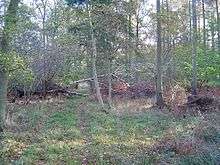Collyweston Great Wood and Easton Hornstocks
Collyweston Great Wood and Easton Hornstocks is a 151.5 hectare biological Site of Special Scientific Interest north of King's Cliffe in Northamptonshire.[1][2] The site is a National Nature Reserve[3] and a Nature Conservation Review site, Grade I.[4] The site is 14 kilometres (8.7 mi) west of Peterborough and the nearest villages are Collyweston, which is 1 kilometre (0.62 mi) north west of the site, and Duddington which is a similar distance to the west.[5]
| Site of Special Scientific Interest | |
 | |
| Area of Search | Northamptonshire |
|---|---|
| Grid reference | TF 012 006[1] |
| Interest | Biological |
| Area | 151.5 hectares[1] |
| Notification | 1984[1] |
| Location map | Magic Map |
Wildlife
These woods have ash, lime and sessile oak, together with wild service-tree, which is an indicator of ancient woodland. The ground flora is very rich, including locally unusual plants such as lily-of-the-valley, wood spurge, great wood-rush, violet helleborine and columbine.[6] Animals found in the woods include slowworm, red kite, common buzzard, lesser spotted woodpecker and great spotted woodpecker.[5]
Historically these woods were once part of Rockingham Forest.[5] and they were continuous with Bedford Purlieus woodland until the mid 19th century.[7] An area of the centre of Easton Hornstocks was quarried and an area within Collyweston Great Wood was deforested to build RAF Collyweston.[7]
A permit from Natural England is required for access.[8]
Archaeology
In the Autumn of 1953 a large Roman site was uncovered by contractors at the old Royal Air Force bomb site located in Collyweston Wood. Large quantities of stone and pottery were reported and a small scale excavation was undertaken which revealed a corner of a rectangular building. After this the chief inspector of ancient monuments was informed and excavations commenced in October 1953 for a month. These revealed a remarkable complex of buildings, a group of dry-stone walled buildings, which included two rectangular buildings, a circular building, an octagonal building and a hexagonal building. These were determined to be the remains of a number of temples and their ancillary buildings. In addition, a large amount of pottery, including a large bowl with a dolphin pattern and others with sea horse decorations were found. These are known to be of local origin. The archaeologists also found jewellery including beautifully decorated brooches and pins. The pottery discovered was found to come from the 1st to the early 4th centuries of the common era.[9]
References
- "Designated Sites View: Collyweston Great Wood and Easton Hornstocks". Sites of Special Scientific Interest. Natural England. Retrieved 19 December 2016.
- "Map of Collyweston Great Wood and Easton Hornstocks". Sites of Special Scientific Interest. Natural England. Retrieved 19 December 2016.
- "Northamptonshire's National Nature Reserves". Natural England. Retrieved 19 December 2016.
- Ratcliffe, Derek, ed. (1977). A Nature Conservation Review. 2. Cambridge, UK: Cambridge University Press. p. 57. ISBN 0521 21403 3.
- "Northamptonshire's National Nature Reserves". Natural England. 1 October 2014. Retrieved 21 March 2020.
- "Collyweston Great Wood and Easton Hornstocks citation" (PDF). Sites of Special Scientific Interest. Natural England. Retrieved 21 March 2020.
- Derek Ratcliffe (1977). A Nature Conservation Review: Volume 2, Site Accounts: The Selection of Biological Sites of National Importance to Nature Conservation in Britain. Cambridge University Press. p. 5. ISBN 0521214033.
- "Collyweston Great Wood and Easton Hornstocks". Woodland Trust. Retrieved 19 December 2016.
- "Roman Collyweston". Collyweston Historical and Preservation Society. Retrieved 21 March 2020.
| Wikimedia Commons has media related to Collyweston Great Wood and Easton Hornstocks. |